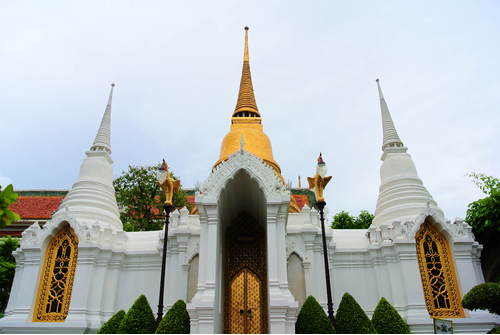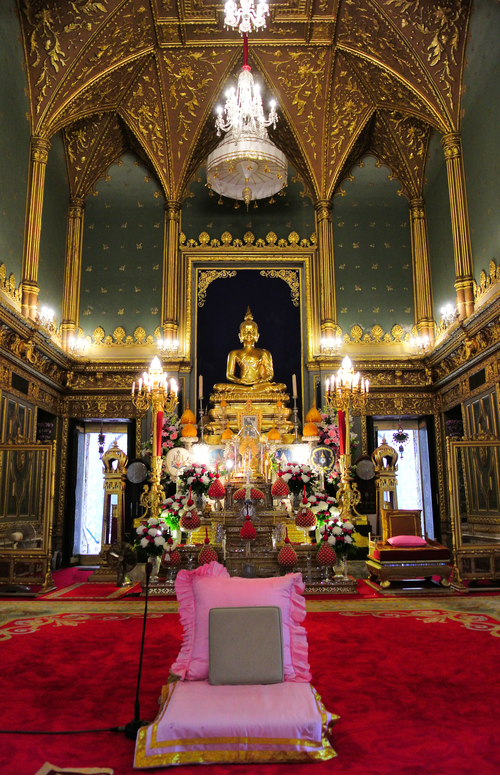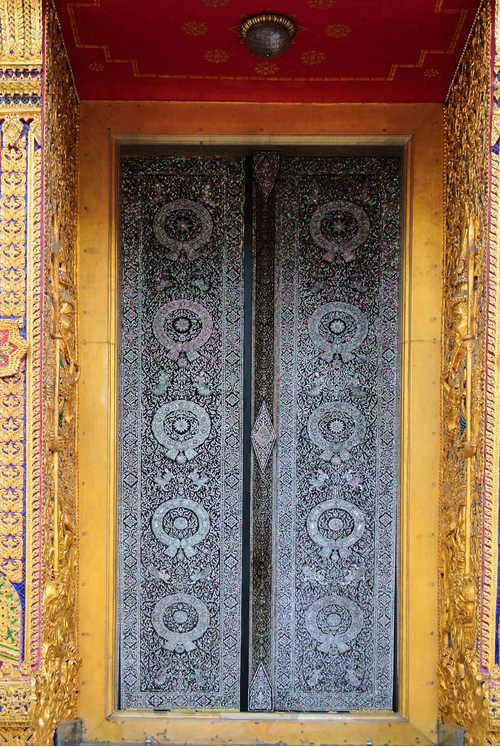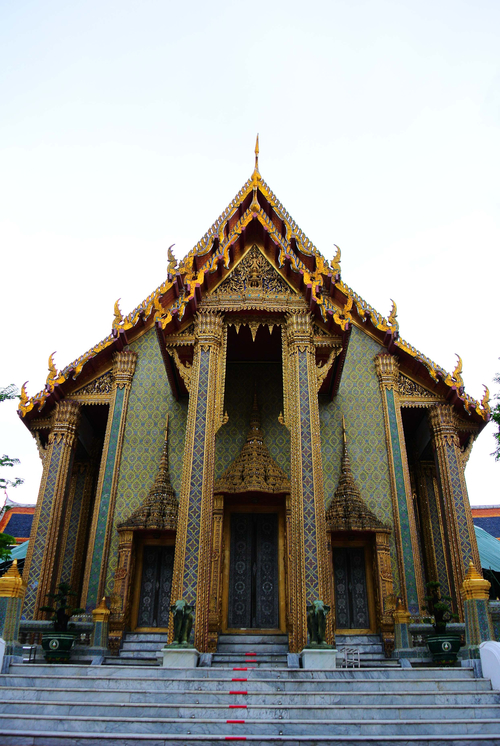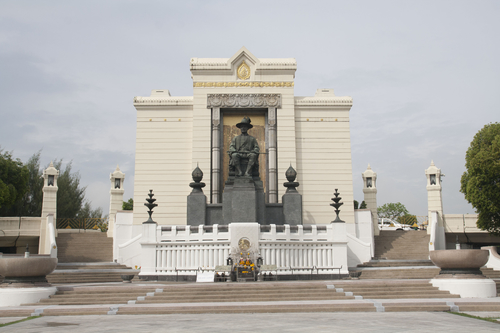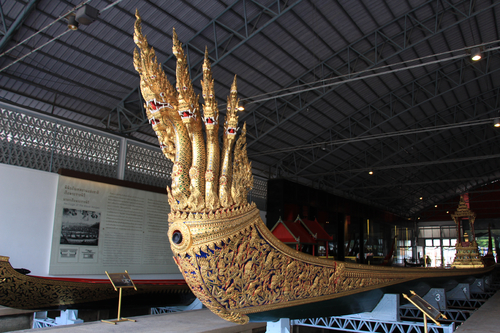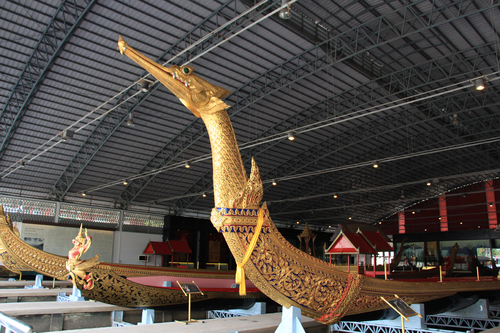ค้นหางานศิลปกรรม
ฐานข้อมูลศิลปกรรมในเอเชียตะวันออกเฉียงใต้
สถาปัตยกรรมสุสานหลวงวัดราชบพิธสถิตมหาสีมาราม
อนุสาวรีย์ต่างๆ ในสุสานหลวงมีทั้งหมด 34 องค์อนุสาวรีย์ที่เป็นประธาน ได้แก่ สุนันทานุสาวรีย์, รังษีวัฒนา, เสาวภาประดิษฐาน และสุขุมาลนฤมิตร์ 1.สุนันทานุเสาวรีย์ เป็นอาคารโถงที่มีส่วนยอดเป็นเจดีย์ทรงระฆัง บุด้วยโมเสคสีทอง เป็นที่บรรจุพระสรีรางคารสมเด็จพระนางเจ้าสุนันทากุมารีรัตน์ พระบรมราชเทวี และสมเด็จพระเจ้าบรมวงศ์เธอ เจ้าฟ้ากรรณาภรณ์เพชรรัตน์ โสภางคทัศนียลักษณ์ อัครวรราชกุมารี พระราชธิดา 2. รังษีวัฒนา อาคารประธานเป็นผังแบบจตุรมุข ที่มีมุขกระสันเชื่อมไปยังมุขทิศเหนือและใต้ส่วนบนของมุขกลางเป็นเจดีย์ทรงระฆังบุด้วยโมเสคสีทองส่วนบนของมุขทิศเหนือและใต้เป็นเจดีย์ทรงระฆังสีขาว เป็นที่บรรจุพระอัฐิและพระสรีรังคารสมเด็จพระศรีสวรินทิราบรมราชเทวี พระพันวัสสาอัยยิกาเจ้า พระราชโอรส พระราชธิดาและราชกุลในพระองค์ 3.เสาวภาประดิษฐานมีลักษณะเหมือนกับอนุสาวรีย์รังษีวัฒนา คืออาคารประธานเป็นผังแบบจตุรมุข ที่มีมุขกระสันเชื่อมไปยังมุขทิศเหนือและใต้ส่วนบนของมุขกลางเป็นเจดีย์ทรงระฆังบุด้วยโมเสคสีทองส่วนบนของมุขทิศเหนือและใต้เป็นเจดีย์ทรงระฆังสีขาว เป็นที่บรรจุพระอัฐิและพระสรีรังคารสมเด็จพระศรีพัชรินทราบรมราชินีนาถ พระราชโอรส พระราชธิดา และราชกุลในพระองค์ 4.สุขุมาลนฤมิตร์เป็นอาคารโถงที่มีส่วนยอดเป็นเจดีย์ทรงระฆังบุด้วยโมเสคสีทอง เป็นที่บรรจุพระสรีรางคารสมเด็จพระปิตุจฉาเจ้าสุขุมาลมารศรี พระอัครราชเทวี สมเด็จพระเจ้าบรมวงศ์เธอ เจ้าฟ้าบริพัตรสุขุมพันธ์ กรมพระนครสวรรค์วรพินิต และเจ้าคุณจอมมารดาสำลี บุนนาคพร้อมทั้งพระประยูรญาติแห่งราชสกุลบริพัตร
สถาปัตยกรรมพระอุโบสถวัดราชบพิธสถิตมหาสีมาราม
ภายในพระอุโบสถเป็นแบบยุโรปผสมแบบไทย เพดานเป็นลายเครือเถาสีทอง ที่ผนังด้านในพระอุโบสถเขียนเป็นรูปดอกไม้ร่วงสีทอง ระหว่างช่องหน้าต่างเป็นรูปอุณาโลมสลับด้วยรูปอักษร “จ”ซึ่งเป็นอักษรตัวแรกของพระปรมาภิไธยพระบาทสมเด็จพระจุลจอมเกล้าเจ้าอยู่หัว เหนือซุ้มประตูกลางด้านในเป็นรูปตราแผ่นดินในรัชกาลที่ 5 หรือที่เรียกว่า ตราอาร์ม ประกอบด้วยสิ่งสำคัญต่างๆ ได้แก่ เครื่องเบญจราชกกุธภัณฑ์ ตราจักรีบรมราชวงศ์ รูปช้างเอราวัณ ช้างเผือก และกริชคด เครื่องราชอิสริยาภรณ์จุลจอมเกล้า ฉัตร 7 ชั้น ขนาบข้างโดยมีราชสีห์และคชสีห์ประคองผนังส่วนบนระหว่างเสาคูหาเขียนภาพพุทธประวัติ ซึ่งออกแบบโดยหม่อมเจ้าประวิช ชุมสาย ช่างหลวงคนสำคัญในสมัยรัชกาลที่ 5 พระประธานในพระอุโบสถ เป็นพระพุทธรูปหล่อปางสมาธิ ขัดสมาธิราบ ทำด้วยสำริดกะไหล่ทองเนื้อแปด ซึ่งเป็นทองคำจากเครื่องแต่งพระองค์ของพระบาทสมเด็จพระจุลจอมเกล้าเจ้าอยู่หัว เมื่อทรงพระเยาว์ ประดิษฐานอยู่บนฐานชุกชีหินอ่อนที่สั่งมาจากประเทศอิตาลี เบื้องบนเหนือองค์พระพุทธรูปมีนพปฎลมหาเศวตฉัตรซึ่งเคยกางกั้นพระโกศพระบรมศพพระบาทสมเด็จพระจุลจอมเกล้าเจ้าอยู่หัว ใต้ฐานชุกชีของพระพุทธอังคีรสเป็นที่ประดิษฐานพระบรมอัฐิรัชกาลที่ 2 ถึงรัชกาลที่ 5 และรัชกาลที่ 7
ประติมากรรมบานประตูประดับมุกลายเครื่องราชอิสริยาภรณ์
บานประตูพระอุโบสถบานซ้ายและขวามีลวดลายประดับมุกเป็นแบบเดียวกันคือ เครื่องราชอิสริยาภรณ์ทั้ง 5 ตระกูล ได้แก่1.เครื่องราชอิสริยาภรณ์อันเป็นโบราณมงคลนพรัตนราชวราภรณ์2.เครื่องขัตติยราชอิสริยาภรณ์อันมีเกียรติคุณรุ่งเรืองยิ่งมหาจักรีบรมราชวงศ์3.เครื่องราชอิสริยาภรณ์จุลจอมเกล้า4.เครื่องราชอิสริยาภรณ์อันเป็นที่เชิดชูยิ่งช้างเผือก5.เครื่องราชอิสริยาภรณ์อันมีเกียรติยศยิ่งมงกุฎไทยลายทั้งหมดประกอบด้วยมุกที่ตัดเป็นชิ้นเล็กๆ เรียงกันเป็นรูปดวงตรา ล้อมด้วยสายสะพายและสายสร้อยมีอักษร จ.ป.ร. ไขว้ และมีตราจักรีคั่นไปเป็นระยะ ซึ่งเป็นเครื่องราชอิสริยาภรณ์ชั้นสูงสุดแต่ละสำรับ นอกจากนี้ยังมีลายอื่นประดับใกล้เคียง ตามลำดับจากด้านบนดังนี้ใต้เครื่องราชอิสริยาภรณ์ดวงที่ 1 เป็นภาพเทพนม ใต้เครื่องราชอิสริยาภรณ์ดวงที่ 2 เป็นภาพเทพธิดาฟ้อน ใต้เครื่องราชอิสริยาภรณ์ดวงที่ 3 เป็นภาพกินนรรำ ใต้เครื่องราชอิสริยาภรณ์ดวงที่ 4 เป็นภาพหนุมานเหาะ ใต้เครื่องราชอิสริยาภรณ์ดวงที่ 5 เป็นภาพอินทรชิตเหาะ พื้นหลังทั้งหมดเป็นลายกระหนก ล้อมกรอบด้วยลายประจำยามก้ามปู
สถาปัตยกรรมวัดราชบพิธสถิตมหาสีมาราม
พระอุโบสถมีรูปแบบเป็นสถาปัตยกรรมแบบไทยประเพณี ตัวอาคารก่ออิฐถือปูน ผนังประดับกระเบื้องเคลือบสีเบญจรงค์ทรงพุ่มข้าวบิณฑ์เขียนลายเทพนม หลังคาทำด้วยเครื่องไม้มุงกระเบื้องเคลือบสี ประดับช่อฟ้า ใบระกา นาคสะดุ้ง หางหงส์ ด้านหน้ามีมุขเด็จ หน้าบันหลักเป็นรูปช้าง 7 เศียร ทูนพานแว่นฟ้ารองรับพระจุลมงกุฎขนาบสองข้างด้วยฉัตรที่มีราชสีห์และคชสีห์ประคอง หน้าบันมุขเด็จเป็นรูปนารายณ์ทรงครุฑ ซุ้มประตูหน้าต่างเป็นยอดแหลมอย่างปราสาทประดับลวดลายปูนปั้นปิดทอง ด้านในบานประตูหน้าต่างเป็นลายรดน้ำพุ่มข้าวบิณฑ์ ด้านนอกเป็นลายดวงตราเครื่องราชอิสริยาภรณ์ชั้นที่หนึ่งรวม 5 ดวง คือ นพรัตน์ราชวราภรณ์ มหาจักรีบรมราชวงศ์ ปฐมจุลจอมเกล้า ประถมาภรณ์ช้างเผือก และประถมาภรณ์มงกุฎไทย ภายในพระอุโบสถเป็นศิลปะตะวันตกแบบโกธิค ประดิษฐานพระพุทธรูปประธานประธาน คือ พระพุทธอังคีรสพระเจดีย์ มีรูปแบบเป็นเจดีย์ทรงระฆังในผังกลม มีส่วนรองรับองค์ระฆังเป็นชุดมาลัยเถา ประดับด้วยกระเบื้องเคลือบสีเบญจรงค์เช่นเดียวกับผนังพระอุโบสถ โดยมีระเบียงคดในผังกลมล้อมรอบพระเจดีย์ หลังคาพระระเบียงมุงกระเบื้องเคลือบสี เสาระเบียงเป็นเสากลมทำด้วยหินอ่อนประดับบัวหัวเสา พระวิหารเป็นอาคารแบบไทยประเพณี รูปแบบใกล้เคียงกับพระอุโบสถแต่มีขนาดเล็กกว่า และต่างกันที่บานประตูและบานหน้าต่างของพระวิหารไม่ใช่งานประดับมุก แต่เป็นงานไม้แกะสลักเป็นลวดลายเครื่องราชอิสริยาภรณ์ ลงรักปิดทองและระบายสี
สถาปัตยกรรมพระปฐมบรมราชานุสรณ์
พระบรมรูปพระบาทสมเด็จพระพุทธยอดฟ้าจุฬาโลกมหาราช หรือพระปฐมบรมราชานุสรณ์เป็นพระบรมรูปประทับนั่งเหนือพระราชบัลลังก์ ผินพระพักตร์มาทางด้านถนนตรีเพชร ทรงเครื่องบรมขัตติยราชภูษิตาภรณ์ ทรงพระมาลา ทอดพระหัตถ์บนพระแสงดาบที่อยู่เหนือพระเพลา มีฐานหินอ่อนเป็นที่รองรับพระบรมรูปหล่ออีกชั้นหนึ่ง เบื้องหลังก่อเป็นกำแพงหินอ่อนกั้นตอนกลางเจาะเป็นช่องลึกคล้ายประตู มีเสาหินสลัก 2 ข้าง หน้าบันประดับลายปูนปั้นรุ)พวงมาลัย เหนือหน้าบันสลักรูปอุณาโลม ด้านหลังกำแพงเป็นแผ่นจารึกหินอ่อน จารึกความเป็นมาของการก่อสร้าง และภายหลังได้มีการเสริมกำแพงให้สูงขึ้นไปอีก เบื้องหน้ามีเครื่องบูชา พุ่มดอกไม้ และพานเครื่องประดับ มีน้ำพุ อยู่ทั้ง 2 ข้าง บริเวณหน้าฐานเป็นรั้วคอนกรีตเสากลม ตอนกลางรั้วเป็นแผ่นหินอ่อนคล้ายเป็นลวดลายไทยวางทอดอยู่ กึ่งกลางแผ่นสลักเป็นรูปช้างหันข้างยืนเหนือแท่น ซึ่งเป็นตราปฐมบรมราชจักรีวงศ์
ประติมากรรมเรือพระที่นั่งอนันตนาคราช
โขนเรือพระที่นั่งอนันตนาคราชเป็นรูปนาค 7 เศียร กลางลำทอดบุษบกสำหรับเชิญผ้าพระกฐินหรือประดิษฐานพระพุทธรูปสำคัญ ลำเรือภายนอกทาสีเขียว ท้องเรือภายในทาสีแดง
ประติมากรรมเรือพระที่นั่งสุพรรณหงส์
โขนเรือเป็นรูปหงส์แกะสลักลวดลายกระหนก ลงรักปิดทองประดับกระจกลำตัวเรือทอดยาวคือส่วนตัวหงส์ ลำเรือด้านนอกทาสีดำภายในทาสีแดงกลางลำเรือทอดบัลลังก์กัญญาและกั้นพระวิสูตรสำหรับเป็นที่ประทับของพระมหากษัตริย์หรือพระบรมวงศานุวงศ์ เมื่อมีการพระราชพิธีจะประดับปลายปากหงส์โขนเรือพระที่นั่งสุพรรณหงส์ด้วยพู่ทำด้วยขนจามรีซึ่งนำมาจากประเทศเนปาลมีลักษณะเป็นขนสีขาวนุ่มละเอียด ปลายพู่เป็นแก้วผลึก
สถาปัตยกรรมเรือพระที่นั่งนารายณ์ทรงสุบรรณ รัชกาลที่ 9
โขนเรือเป็นประติมากรรมรูปพระนารายณ์ 4 กร ทรงเทพศัตราได้แก่ ตรี คฑา จักร สังข์ ทรงเครื่องภูษิตาภรณ์และมงกุฎยอดชัย ประทับยืนเหนือครุฑ ไม้หัวเรือแกะสลักปิดทองร่องชาดประดับกระจกสีขาบ พื้นลำเรือทาสีแดง ลำเรือประดับลายก้านขดกระหนกเทศ กลางลำเรือประดับบัลลังก์กัญญา ท้ายเรือพระที่นั่งตลอดปลายประดับลวดลายกระหนกแทนขนปีกและหางครุฑ
